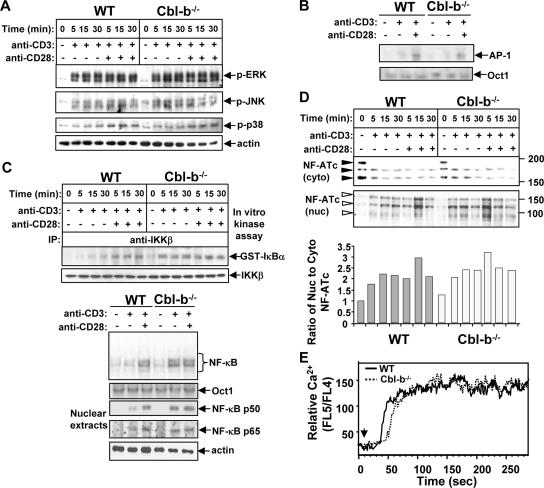FIG. 1.
Cbl-b negatively regulates the activation of NF-κB but not that of MAPKs, AP-1, and NF-AT in T cells. (A) WT and Cbl-b−/− T cells were stimulated with anti-CD3 Ab or anti-CD3 and anti-CD28 Abs for 5, 15, and 30 min and lysed. The cell lysates were analyzed with Abs against phospho-ERK, phospho-JNK, and phospho-p38 MAPK. The membranes were reprobed with antiactin Ab. (B) For detection of AP-1 activity, both WT and Cbl-b−/− T cells were stimulated with anti-CD3 Ab or anti-CD3 and anti-CD28 Abs for 30 min and nuclear extracts were prepared. AP-1 activity was detected by EMSA. (C) WT and Cbl-b−/− T cells were stimulated as in A. The cell lysates were immunoprecipitated with anti-IKKβ, and incubated with GST-IκBα fusion protein. The phosphorylation of IκBα was detected using anti-phospho-IκBα Ab (upper panel). WT and Cbl-b−/− T cells were stimulated with anti-CD3 Ab or anti-CD3 and anti-CD28 Abs for 30 min, and nuclear extracts were subjected to EMSA analysis with either the NF-κB or the Oct-1 probe. Alternatively, the nuclear extracts were blotted with anti-p50 and -p65 Abs (lower panel). (D) WT and Cbl-b−/− T cells were stimulated with anti-CD3 Ab or anti-CD3 and anti-CD28 Abs for 5, 15, and 30 min, and cytosolic and nuclear fractions were prepared and analyzed with anti-NF-ATc Ab. NF-ATc translocates rapidly from the cytoplasm (cyto) to the nucleus (nuc). NF-ATc in its phosphorylated state is present as several bands migrating with apparent sizes of 160 to 190 kDa (filled arrows). Nuclear NF-ATc is dephosphorylated and migrates more rapidly as apparent bands at 80 to 150 kDa (open arrows). The cytoplasmic and nuclear NF-ATc bands were quantitated by densitometry, and the ratio of nuclear to cytoplasmic NF-ATc was calculated. The WT nuclear to cytoplasmic NF-ATc ratio was defined as 1. (E) WT and Cbl-b−/− T cells were loaded with INDO-1, incubated with anti-CD3, and cross-linked with rabbit anti-hamster IgG. Ca2+ flux was monitored by flow cytometry. Arrowheads indicate time of addition of cross-linking Ab. The data shown are representative of three independent experiments. −, absence of; +, presence of.

